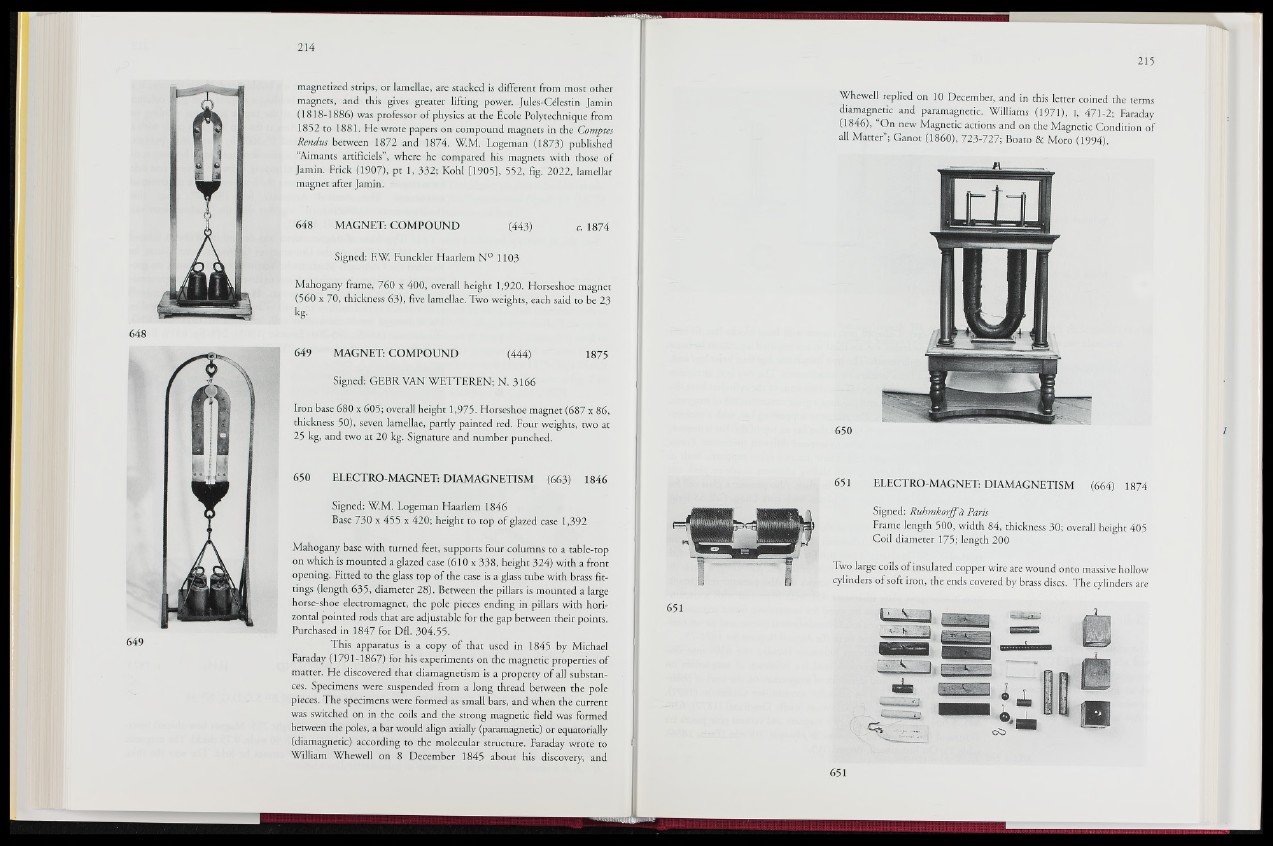
magnetized strips, or lamellae, are stacked is different from most other
magnets, and this gives greater lifting power. Jules-Célestin Jamin
(1818-1886) was professor of physics at the École Polytechnique from
1852 to 1881. He wrote papers on compound magnets in the Comptes
Rendus between 1872 and 1874. W.M. Logeman (1873) published
“Aimants artificiels”, where he compared his magnets with those of
Jamin. Frick (1907), pt 1, 332; Kohl [1905], 552, fig. 2022, lamellar
magnet after Jamin.
648 MAGNET: COMPOUND (443) c. 1874
Signed: F.W Funckler Haarlem N° 1103
Mahogany frame, 760 x 400, overall height 1,920. Horseshoe magnet
(560 x 70, thickness 63), five lamellae. Two weights, each said to be 23
%
649 MAGNET: COMPOUND (444) 1875
Signed: GEBR VAN WETTEREN; N. 3166
Iron base 680 x 605; overall height 1,975. Horseshoe magnet (687 x 86,
thickness 50), seven lamellae, partly painted red. Four weights, two at
25 kg, and two at 20 kg. Signature and number punched.
650 ELECTRO-MAGNET: DIAMAGNETISM (663) 1846
Signed: W.M. Logeman Haarlem 1846
Base 730 x 455 x 420; height to top of glazed case 1,392
Mahogany base with turned feet, supports four columns to a table-top
on which is mounted a glazed case (610 x 338, height 324) with a front
opening. Fitted to the glass top of the case is a glass tube with brass fittings
(length 635, diameter 28). Between the pillars is mounted a large
horse-shoe electromagnet, the pole pieces ending in pillars with horizontal
pointed rods that are adjustable for the gap between their points.
Purchased in 1847 for Dfl. 304.55.
This apparatus is a copy of that used in 1845 by Michael
Faraday H791-1867) for his experiments on the magnetic properties of
matter. He discovered that diamagnetism is a property of all substances.
Specimens were suspended from a long thread between the pole
pieces. The specimens were formed-as small bars, and when the current
was switched on in the coils and the strong magnetic field was formed
between the poles, a bar would align axially (paramagnetic) or equatorially
(diamagnetic) according to the molecular structure. Faraday wrote to
William Whewell on 8 December 1845 about his discovery, and
Whewell replied on 10 December, and in this letter coined the terms
diamagnetic and paramagnetic. Williams (1971), I, iff? I -2; Faraday
(1846), “On new Magnetic actions and on the Magnetic Condition of
all Matter”; Ganot (1860), 723-727; Boato & Moro (1994).
650
651 ELECTRO-MAGNET: DIAMAGNETISM (664) 1874
Signed: Ruhmkorffà Paris
Frame length 500, width 84, thickness 30; Overall height 405
Coil diameter 175; length 200
Two large coils of insulated copper wire are wound onto massive hollow
cylinders of soft iron, the ends covered by brass discs. The cylinders are
651